Need to know your recurve from your compound and your takedown from your barebow? There are lots of different bow types out there, different classes, descriptions and material compositions. Our guide will take you through everything you need to know to become an expert!
You may also be interested in:
Do you want to see some examples and know what the best recurve bow is? Or maybe you’re interested in the more traditional style of archery and would like to see what we’d consider to be good longbow?
More recent styles of bows are far more powerful than recurves and longbows. We’ve also rounded up a great selection of both these types these 2 articles, the best crossbows and the best compound bows. Check them out too!
Table of Contents
Common Modern Bow Types
Recurve Bows
The recurve bow is the bow you’ll see used at the Olympics because (at the moment) it’s the only style of bow allowed. It’s called a recurve because whilst the majority of the bow curves towards the archer, the tips of the limbs curve back the other way (they ‘re-curve’), the diagram shown should help to make this clear.
These curved tips straighten as the bow is drawn and spring back to their initial curved state when the arrow is released, this extra spring adds to the power and speed to the shot.

The main parts of a recurve bow:
- Riser – The riser is the main central part of the bow.
- Limbs – The extremities of the bow which attach the string and provide the shooting force
- Grip – The part of the riser which you hold
- Arrow Rest/Arrow Shelf – Some bows allow you to rest the arrow on the shelf and some can be fitted with a specific arrow rest
Modern Recurve
Modern recurve bows are normally takedown bows meaning that the top and bottom limb can be removed, you should be able to see the thumbscrews in the picture. As an archer becomes more experienced, recurve bows can have sights, range finders, pressure buttons, clickers, weights, silencers and stabilizers fitted. Click any of those links to see examples of these accessories.
A modern recurve bow can have a riser made from aluminium, magnesium, carbon fiber, specialist alloy or wood, and limbs made from laminated composite materials, graphite or glass..
Traditional Recurve
Traditional bows made from single pieces of wood and wood compositions can also be recurved. Mongolian and Turkish are examples of traditional recurved bows. We cover traditional bows later in this article. When you think or say ‘recurve‘ you are really talking about the shape of the bow, that shape can apply to any category of bow.
Compound Bows
A compound bow normally has a cam or pulley system at the top of the limbs to aid the archer when drawing the bow this system multiplies the power stored in the limbs that is transferred to the string and arrow when released and allows for a more powerful shot with less effort on the part of the archer, it also makes it easier to hold the string in the drawn position for long periods. Here’s a link to an article where we take a more in-depth look at the parts of a compound bow.
Because of the mechanics involved compound bows are normally not as easy to disassemble and you won’t find so many (if any) takedown variants available.
Here’s a great article on understanding more about the pro and cons of compound bows vs recurve bows. Check it out!
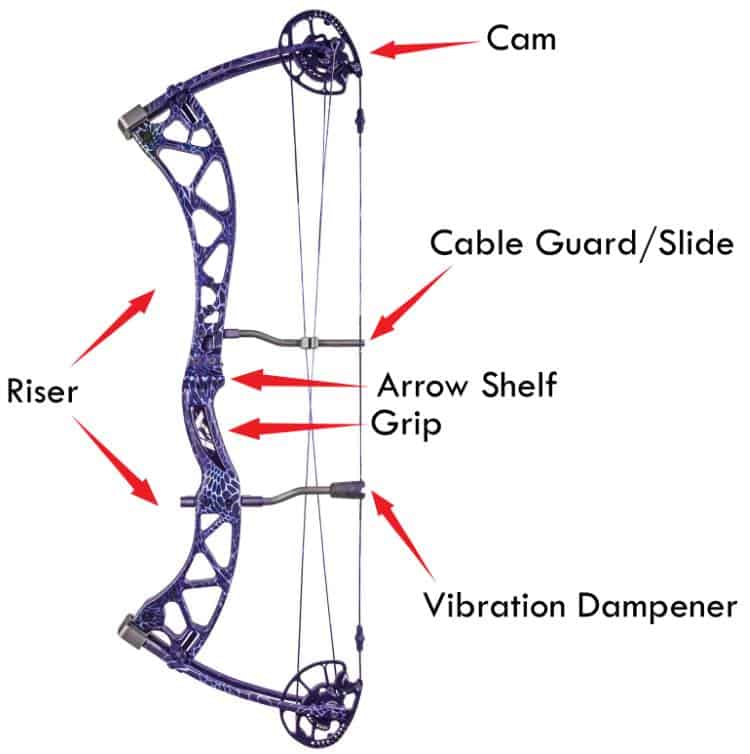
Crossbows
A crossbow is a bow that is held more like a gun or a rifle. It has a mechanism to allow the string to be pulled back and latched into place until the trigger is pressed. Crossbow arrows are normally referred to as ‘Bolts‘ and pulling the trigger on a crossbow will fire the bolt. There are small variants of the crossbow called the ‘pistol‘ crossbow. They are designed to be held and fired with one hand and called so because they resemble a pistol. The more common variant is full sized, held with both hands and the butt is positioned into the shoulder (like a rifle) when firing.
Crossbows can come with recurved or compound limb arrangements. Here’s an article we’ve written which rounds up and reviews some of the best crossbows available today.

Compound Crossbow
A compound crossbow is a crossbow with a pulley or cam system at the ends of the limbs to increase the power of the shot and decrease the draw weight. As compound limbs are more efficient they can also make the bow narrower than a recurve equivalent with the same power. To understand more about the differences between recurve and compound limbs check out this article on recurve vs compound bows. Whilst it isn’t specific to crossbows, the principles remain the same.
You might also be interested in this piece that covers the differences between compound bows and crossbows.
Bow Terminology
Takedown
A takedown bow is designed to be easily disassembled for transportation, you may confuse ‘takedown’ in the title of a bow and think it refers to ‘taking down prey’ in hunting, this isn’t the case, it just means you can take the bow to pieces! Normally a recurve takedown bow will have removable top and bottom limbs so once the string is removed the bow can be broken into 3 pieces.
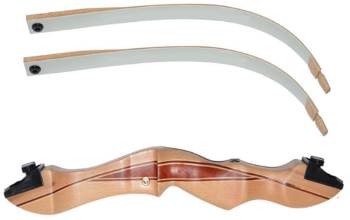
Barebow
Barebow refers to a bow with no sight, no stabilisers and within a certain unstrung size range (for competitive purposes). A competitive barebow is usually a modern bow but without any of the modern aids such as a sight, clicker and stabilizer. The exception to this perhaps being the addition of weights to the riser in certain models. Someone who shoots a traditional or modern bow without any aids can be said to be shooting instinctively.
Self Bow
If you read or hear the phrase ‘self bow‘ this is referring to a bow made from a single piece of wood. Many traditional bow styles such as the longbow and flatbow are self bows.
Specialist Bow Types
Flight Bows
Flight archery is a specialised archery discipline in which the name of the game is to get the arrow to fly as far as you can. Specialized flight bows have been developed for this purpose, a flight bow is normally a recurve or compound bow and sometimes (because flight archery uses short arrows, for aerodynamic reasons) the arrow can be drawn back inside the arc of the bow limbs and can rest on the arm of the archer to allow for a greater draw and greater power in the shot.
Horse Bows
Mounted archers tend to use a specialised type of small traditional recurve barebow which you’ll see referred to as a horse bow or a shortbow.
Foot Bows
A foot bow is a specialist type of bow, normally a composite bow with a big draw weight, designed to be drawn from a lying position using both hands whilst the feet hold the bow. This type of bow is designed for raw power and you’ll find them used in flight archery.
Survival Bows
Due to the rise of modern fiction predicting some sort of apocalypse and indeed the rise in people wanting to place themselves in extreme survival situations or prepare for the worst (just google ‘Prepper‘ or ‘SHTF‘) specialist types of bow have evolved called ‘Survival Bows’. Normally a survival bow is a light, compact takedown (or folding) D style bow which can be easily assembled, transported and carried and (as pictured) may even allow for storage of arrows within the body. There are plenty of these styles of bow available on the market today, in fact here is a link to our round up of the best survival bows.
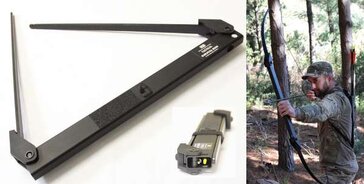
Traditional Bow Types
Longbows
The longbow is a traditional (one piece or ‘self’) bow and the most widely known example is the English longbow which was normally made from yew or wych elm woods. Modern longbows (like these in our best longbow roundup) can be made from laminating different materials together to give a lighter and stronger result. A longbow has rounded limbs and is normally as big as an archer standing over 5 feet (1.5 m) to allow a full draw.
The limbs on a longbow are normally not recurved and this gives the bow the well known D shape.
The longbow was the go-to weapon of English soliders from the 14th century right up until the introduction of firearms.
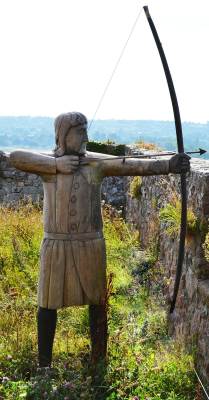
Shortbows
You might also come across the term ‘shortbow‘. Today a shortbow generally refers to a small style of recurved bow that is used mainly by mounted archers. Shorter bows are easier to use whilst on horseback. They have their own set of advantages and disadvantages when compared to longbows.
Flatbows
The flat bow was traditionally the weapon of the Native American and so you might hear it referred to as the ‘American Flatbow’. It has rectangular cross sectional limbs which make it look… well… flat! Because the limbs are wide you’ll normally find that they narrow towards the handle to allow the handle to be gripped. It is possible although not a certainty that this type of bow was the bow that preceded the modern recurve bow.
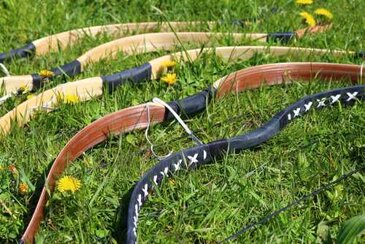
The Kyudo Bow (Yumi)
Kyudo is a Japanese martial art which translates as ‘The Way of the Bow’, and Kyodo bow is similar to a longbow, with rounded limbs and is a one piece bow normally 2m in height.
A bow used in Kyudo is traditionally made from bamboo, but bamboo is delicate and easily damaged so modern equivalents come in fibreglass or carbon fiber.
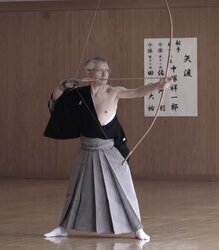
Reflex Bow
A reflex bow has limbs which curve away from you when it is unstrung. When drawn the limbs flex into the normal curved position, it is this desire for them to flex back against that position that gives power to the shot.
Bow Construction Materials and Methods
Wooden Bows
Most traditional bows such as the longbow, flatbow and yumi are made from some type of wood, yew, wych elm, bamboo, rosewood etc..
Fiberglass Bows
Fibreglass is one step up from wood in terms of a material for creating strong and flexible bows and limbs, however it is not the best material for manufacturing high end modern bows. Fibreglass bows are normally cheaper than other bows and are used for children’s toy bows or specialist bows.
Composite Bows
A composite bow is a bow made of the composition of several materials (fibreglass, wood etc), this composition gives better strength and flexibility than when using a single type of material. A compound bow normally refers to a traditional bow made from wood and sinew, modern composite bows like these are normally laminated.
Laminated Bows
Lamination is a technique whereby layers of differing material are glued/heated or welded together to form a new material with greater strength than the original. Lamination is a technique used in the manufacture of most good recurve and compound bow limbs.
Solid Glass/Glass Bows
Some modern bows have solid glass or graphite limbs made using an extrusion process, these materials have differing strengths and properties to lamination giving a different feel and power to the bow, albeit at a higher price point normally.
I enjoyed your article very much. It was well written and informative. Thank you.
Thanks Harry!
I just got a small compound bow and had a friend walked me though to get to know it. Then we did some archery. I must say I did pretty good. But I did a bit of goggleing and found your sight. I did some new learning reading it I had no idea there were so many bows to think about.
Thank you Rose Hadden